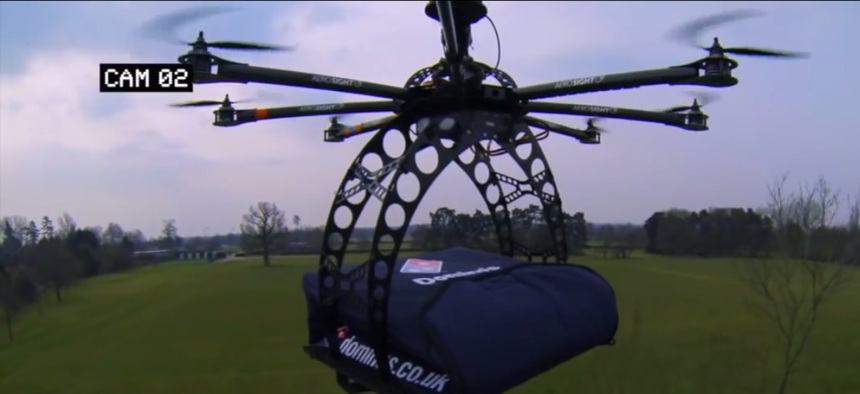
Dominos PIzza UK via Youtube
Drones Deliver Missiles, But Not Pizza... Yet
Here are five reasons why drones don't beat Dominoes. By Philip A. Stephenson
Based on news like this, the drone economy of the future can seem like it’s just around the corner, but don’t get carried away: Bloomberg reports that venture capitalist Tim Draper, backer of startups like Skype and Baidu, recently backed software startup DroneDeploy, a land mapping software technology firm for unmanned commercial drones. In just the first nine months of 2013, investors poured $40.9 million into startups working on commercial drone applications.
Draper told reporters in an email that, “Everything from pizza delivery to personal shopping can be handled by drones.”
The idea isn’t inconceivable. Last year, Domino’s Pizza UK and marketing firm T+biscuits attracted attention with their Domicopter video, which features an eight-rotored remote-control helicopter, taking a 10-minute flight over picturesque Guildford, UK to deliver two pizzas.
While the stunt showed that it’s possible to deliver pizza by drones, here are five reasons why mainstreaming the practice still isn’t feasible: Cost
A remote controlled “octocopter” similar to the Domicopter (the Cinestar 8) costs between $8,000 and $11,000. Add another $500-$1,200 for a remote control. And that’s not counting the salary of the remote control pilot and her training. Drones like the Domicopter, although technically “unmanned,” aren’t autonomous. Autonomy would require the additional expense of GPS and autopilot technologies. What’s more, the cost of insuring/replacing a drone damaged by, say, weather, vandalizing Luddites or teenage delinquents could be considerable.
Operating range
Various configurations of the helicopters, from Quadrocopter and Aerobot, have maximum operating ranges from the operator of 250 to 500 meters (800-1,600 feet). Boosting that range to 1,000 meters costs another $2,200. Current battery technologies only support reported flight times of 8 to 15 minutes. And don’t forget about the return trip!
Payload
Most of these machines were designed to carry cameras, not pizzas. Mid-range payload capacities hover around four pounds—not nearly enough for two pizzas—even in perfectly calm skies. Two large pizzas weigh closer to six pounds.
Liability
One of the enormous business advantages of running a pizza franchise in the US is hiring cheap contract labor to do deliveries. Domino’s Pizza is not liable for the health insurance or incidental murder of a delivery person on the job. In practice, although franchise owners can be found liable for automotive damages caused by their drivers, insurance costs are most often punted to the drivers. If pizza companies used drones, they could be liable for damages caused by malfunctioning drones should they fall from the sky.
Airspace and security restrictions
While commercial drones are currently legal in Europe in specialized cases (for instance, for use in film production), a rationale will have to be developed to regulate their use if they proliferate. In the US, concerns about airspace security and privacy will keep the technology illegal until 2015, the deadline set by the US Federal Aviation Administration to outline legal parameters for their use.